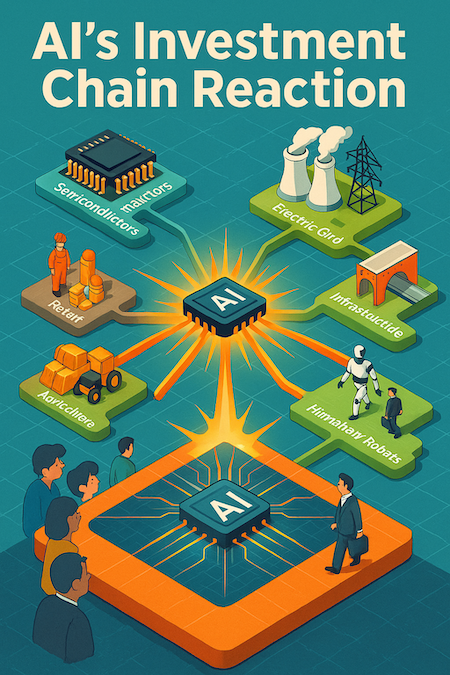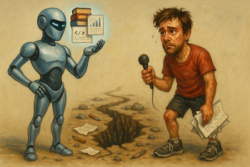- Insider’s guide to the AI investing galaxy
- The next phase of AI is upon your portfolio
- Financial markets allow you to magnify gains
The AI boom used to be so easy to understand. First, the companies developing AI soared in value. Which was any tech firm with a cash hoard to spend on data centres.
Then companies selling AI solutions soared. Palantir (NASDAQ: PLTR) is up hundreds of percent.
But AI needs vast amounts of computing power to function. So the companies providing AI developers with computer chips went bonkers next. Now NVIDIA’s value exceeds that of Europe’s major stock markets combined.
But computer chips need electricity and cooling capacity. Vast amounts of it. And so innovative energy companies like small modular nuclear reactor (SMR) stocks soared.
It turns out the power grid can’t handle this much energy demand. So electric infrastructure companies suddenly sold-out production for years to come as anticipated electricity demand went from slow decline to rapid incline.
What’s next?
Which sector of the stock market will AI inflate now?
It’s not hard to guess. You just need to take a close look at what the AI insiders are buying. After all, they’d know what their own AI boom will soak up next.
They were onto NVIDIA early. And developed their own SMR companies. They complained about the grid’s constraints. And developed tech to solve the problems.
Elon Musk reportedly bought a gas power plant overseas to ship to the US!
So, what are they up to now?
History tells us…
AI eats world
If you remember the tech bubble, it followed a similar sequence.
First, internet stocks themselves soared. Then internet infrastructure like telecoms. And, eventually, it was the businesses that figured out how to use the internet in other industries that succeeded.
Amazon used the internet for retail. Social media for selling advertising. YouTube and Netflix for videos. OnlyFans for…
Well, I think that final phase of AI has begun. AI insiders are placing their next series of bets on the existing companies that stand to gain the most from AI.
It might be to cut costs. Call centre staff are losing jobs rapidly thanks to AI. As are research and legal jobs. That should make many companies far more profitable.
AI could also revolutionise manufacturing and agriculture by making robots better than humans in a far greater sphere of tasks. Our cost of living would tumble if only the Bank of England would let it.
Car companies are already successfully testing humanoid robots that replace workers in factories, rather than rebuilding manufacturing plants around robotic arms.
Self-driving cars are an AI-based solution that’s yet to figure out its business model. Will people even own cars in the future, or subscribe to a ride-service?
That question would’ve seemed just as absurd to Blockbuster and DVD manufacturing companies not that long ago. But the internet’s streaming replaced ownership.
If self-driving cars become ubiquitous, what does that mean for infrastructure projects, total car sales and urban planning? Most cars sit unused most of the time. We could be on the cusp of radically more efficient vehicle use. Which means far less vehicles are needed.
Carpark buildings could become worthless…or worth more as they’re redeveloped. Cities could become far better places to be as our use of cars becomes highly efficient. But what’ll that mean for public transport?
While I’ve been wondering whether my children will learn handwriting, they could end up skipping typing altogether thanks to AI!
Will gardening exist as a profession, or will there only be landscape artists in Japan telling robots what to do in my yard?
Could AI help you design your own clothes, triggering a fashion boom for some businesses and financial implosion for famous fashion houses?
How much would you pay to let me design your garden or outfit?
Each of these investment opportunities is created by AI, but isn’t directly part of AI today. It’s all about how AI will change businesses around us. That’s the next phase of AI for investors.
But it’s the final phase that I want to turn your attention to today…
AI will radically increase the commodity intensity of living
Our standard of living is constrained by the need to have people do things for us. How often we take a taxi is dependent on the number of taxi drivers available. How often we fly depends on the number of pilots. How many houses are built supposedly depends on the number of unionised workers with the right permits and licenses…
Politicians have been trying to unclog this bottleneck with immigration. Which hasn’t gone very well…
The thing is that AI is disproportionately good at replacing such human bottleneck jobs.
This is how prosperity advances, by the way. Most of humanity used to work in agriculture just to keep us fed. Now a tiny proportion of people work in agriculture, but produce far more food.
The prosperity we have gained can be measured in the fact that many workers who would’ve been stuck in the fields are now producing something else we want instead.
So, displacement of workers due to productivity gains is a measure of future prosperity. It’s how our economy grows.
Good luck to any politician trying to sell that though!
But my point is what this unlocks. If the amount of goods and services we can consume is uncoupled from the number of people in our economy, we could be on the cusp of extraordinary levels of prosperity.
And that implies truly vast demand for one thing. Which I’ll reveal early next week.
Until next time,

Nick Hubble
Editor, Investor’s Daily
P.S. If AI really is going to change everything—from who builds our homes to who styles our wardrobes—then the biggest winners may not be tech firms at all. I’m tracking where the AI insiders are placing their next bets… and let’s just say, the clues point to something big. Details coming next week. Keep watching.




